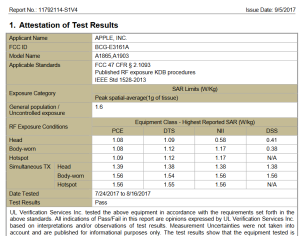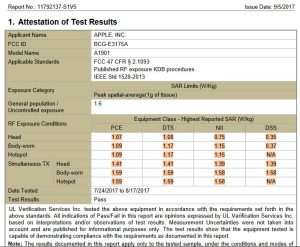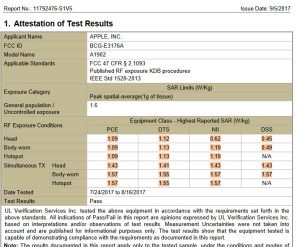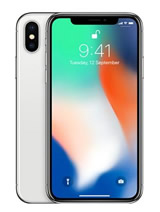Apple iPhone X Radiation Levels
| Radiation Levels | Head | Body | Hot Spot |
|---|---|---|---|
| Cellular Only | 1.08 W/kg | 1.08 W/kg | 1.09 W/kg |
| Wi-Fi + Cellular | 1.39 W/kg | 1.56 W/kg | 1.56 W/kg |
Apple iPhone X SAR Level Summary:
The cellular transmission SAR values for the Apple iPhone X (FCC ID BCG-E3175A) are 1.08 W/kg (watts per kilogram) at the head and 1.08 W/kg when worn on the body. The hotspot/Airplay SAR level is 1.09 W/kg. The simultaneous transmission SAR values for iPhone X (cellular plus Wi-Fi) is 1.39 W/kg at the head, 1.56 W/kg when worn on the body, and 1.56 W/kg when used as a hotspot simultaneously with other transmitters active.
iPhone X
| Select a phone to compare iPhone X SAR levels to other popular phones |
| Cell Phone Usage & Radiation Exposure | ||||||||||||
Apple iPhone X Safety Tip:How Much Will Turning Off Wi-Fi and Bluetooth Reduce Radiation?This SAR chart reveals how turning off Wi-Fi and Bluetooth on your Apple iPhone X can significantly reduce your exposure to radiation. Our SAR comparison chart shows that by simply turning off Wi-Fi and Bluetooth transmitters, you can lower the RF radiation exposure to your head by 22.3%, and you can lower exposure to the body by 30.8%, when considering these differences between cellular-only (Wi-Fi/Bluetooth OFF) and simultaneous use exposure (Wi-Fi/Bluetooth ON), a wise way to reduce excessive phone radiation is to tap off unnecessary transmitters when not in use! Additionally, when using your phone as a hotspot, turning off Bluetooth can reduce your exposure by up to 43.1% according to the FCC SAR report for device number BCG-E3175A. Apple iPhone X SAR Levels
|
Key Takeaways
- Children vs Adults: Children have higher SAR levels due to thinner skulls and developing tissues, making them more vulnerable to radiation.
- Wi-Fi Impact: Simultaneous use of cellular and Wi-Fi transmission increases SAR levels for all age groups.
- Precautionary Measures: Using radiation protection products like QuantaCase can help mitigate these risks, especially for younger users.
By understanding these differences, parents and guardians can make informed decisions to better protect their children from excessive microwave radiation exposure, emphasizing the need for safer smartphone usage practices and protective accessories like QuantaCase.

| Children vs Adults Radiation Exposure |
The Specific Absorption Rate (SAR) of a mobile device measures the amount of radio frequency energy absorbed by the body during device usage.
The SAR values for the iphone-x (FCC ID BCG-E3175A) are as follows:
- 1.08 W/kg when held at the head with cellular transmission only
- 1.08 W/kg when worn on the body with cellular transmission only
- 1.09 W/kg when used as a Hotspot or Airplay
- 1.39 W/kg when held at the head with simultaneous cellular and Wi-Fi transmission
- 1.56 W/kg when worn on the body with simultaneous cellular and Wi-Fi transmission
- 1.56 when used as a Hotspot simultaneously with other transmitters active.
Apple iPhone X - SAR Levels
FCC SAR Levels
- FCC Approval Date This is the date the phone SAR test was completed before the phone's release to the public as required by law. 05 September 2017
- FCC ID The FCC ID is the code used to register a device for FCC compliance BCG-E3175A
- FCC Report Link A direct link to the FCC's website for confirming SAR levels that are listed on our website - We did the homework for you!
- US SAR Ratings USA Legal Limit is 1.6 W/kg USA Legal Limit is 1.6 W/kg - FCC SAR testing is measured in watts per kilogram (or W/kg) averaged over ONE gram of simulated biological tissue.
- Head SAR Level SAR test when held against your head when only using cellular service. Wifi and other transmitter are NOT active 1.08 w/kg
- Body SAR Level SAR test when held against your body only using cellular service. Wifi and other transmitter are NOT active 1.08 w/kg
- Product Specific Use SAR test when held against your body only using the phone as a hotspot. Cellular and other transmitter are NOT active 1.09 w/kg
- Simultaneous Transmission The highest possible SAR recorded with ALL transmitters active, Cellular, WiFi, and Hotspot 1.56 w/kg
- Simultaneous Head The highest possible SAR test when held against your HEAD with cellular and WiFi transmitters active, 1.39 w/kg
- Simultaneous Body The highest possible SAR test when held against your BODY with cellular and WiFi transmitters active, 1.56 w/kg
- Hotspot SAR The highest possible SAR test when held against your BODY using the phone as a hotspot with cellular and WiFi transmitters active, 1.56 w/kg
EU SAR Level
- EU SAR Ratings SAR limits within the EU, following IEC standards. For mobile phones, and other such hand-held devices, the SAR limit is 2 W/kg averaged over the 10 g of tissue absorbing the most signal (IEC 62209-1).
- Head SAR Level 0.87 w/kg
- Body SAR Level 0.97 w/kg
iPhone X finally authorized by the FCC!
The iPhone X Specific Absorption Rate (SAR) measurements have finally been updated by Apple on its official website, and the message displayed pertaining to non-approval for FCC SAR compliance has been removed.
Apple waited until last minute to inform the public on thermal simulations representing how much microwave radiation is absorbed into your body and converted into heat. SAR levels are important safety indicator that informs an iPhone X user how much radio frequency radiation their body is absorbing when the 10th anniversary iPhone users’ phone is operating at maximum RF power levels. RF Safe needs to be on record that SAR testing is not an adequate testing measure to ensure your safety from exposure to RF Radiation — as MANY studies do support non-thermal hazards to microwave exposure.
The SAR values listed below are for the spectrum licensed to cell phone carriers (i.e., PCE). Apple lists slightly higher values on its website for the head and body which represent cell phone communications using unlicensed spectrum (i.e., NII). Note that Apple does not report on its website the SARs in hotspot mode or for simultaneous transmission of cellular and Wi-Fi.
It is VERY important to note the minimum separation distance for body-worn testing is 5 mm (about two-tenths of an inch). You must at all times have this amount of distance between your body and phone when in operation to comply with regulatory safety values below!
The SAR for the iPhone X Model A1865 and A1903: FCC ID BCG-E3175A

Well at last, according to test reports filed with the Federal Communications Commission (FCC), the Specific Absorption Rate (SAR) for the iPhone X Model FCC ID BCG-E3161A (GSM and CDMA) for cellular transmission is 1.08 watts per kilogram (w/kg) at the head, and 1.08 w/kg when worn on the body. The hotspot/Airplay SAR is 1.09 w/kg. The SAR for simultaneous transmission (cellular plus Wi-Fi) is 1.39 w/kg at the head, 1.56 w/kg when worn on the body, and 1.56 w/kg when used as a hotspot simultaneously.
Applicable Networks for Apple iPhone X Model A1865 and A1903:
U.S. Virgin Islands: Sprint Wireless
Australia: Optus, Telstra, Virgin, Vodafone
China: China Mobile, China Telecom, China Unicom
Hong Kong: 1O1O and CSL, China Mobile Hong Kong, SmarTone
New Zealand: 2degrees, Spark, Vodafone
Puerto Rico: Open Mobile, Sprint Wireless
The SAR for the iPhone X Model A1901: FCC ID BCG-E3175A

iPhone X SAR level (GSM, no CDMA) for cellular transmission is 1.07 watts per kilogram (w/kg) at the head, and 1.09 w/kg when worn on the body. The hotspot/Airplay SAR is 1.09 w/kg. The SAR for simultaneous transmission (cellular plus Wi-Fi) is 1.41 w/kg at the head, 1.59 w/kg when worn on the body, and 1.59 w/kg when used as a hotspot simultaneously.
Applicable Networks for iPhone 8 Model A1901:
United States: AT&T, T-Mobile USA
Austria: 3, A1, T-Mobile, tele.ring
Belgium: BASE, Mobistar, Proximus, Telenet
Canada: Bell, Cityfone, eastlink, Fido, Koodo, MTS (Canada), PC Mobile, Rogers, Sasktel, TbayTel, Telus, Videotron, Virgin Mobile
Denmark: 3, TDC, Telenor, Telia
Finland: DNA, Elisa, Saunalahti, Sonera
France: Bouygues, Free Mobile, La Poste Mobile, NRJ Mobile, Orange, SFR, Virgin Mobile
Germany: 1&1, O2, Telekom, Vodafone
Ireland: 3, Meteor, Vodafone
Italy: 3, TIM, Vodafone
Luxembourg: Orange, Post Telecom, Tango Mobile
Mexico: AT&T, Movistar, Oui, Telcel
Netherlands: KPN, T-Mobile, Tele2, Vodafone
Norway: Telenor, Telia
Portugal: MEO, NOS, Vodafone
Puerto Rico: AT&T, Claro, T-Mobile USA
Singapore: M1, Singtel, StarHub
Spain: Movistar, Orange, Vodafone, Yoigo
Sweden: 3, Tele2, Telenor, Telia
Switzerland: Salt, Sunrise, Swisscom, UPC, Wingo
U.S. Virgin Islands: AT&T
United Arab Emirates: du, Etisalat
United Kingdom: 3, BT, Everything Everywhere, Giffgaff, O2, Sky, Virgin Mobile UK, Vodafone
The SAR for the iPhone X Model A1902: FCC ID BCG-E3176A
 iPhone X SAR level for cellular transmission is 1.09 watts per kilogram (w/kg) at the head, and 1.09 w/kg when worn on the body. The hotspot/Airplay SAR is 1.09 w/kg. The SAR for simultaneous transmission (cellular plus Wi-Fi) is 1.48 w/kg at the head, 1.59 w/kg when worn on the body, and 1.59 w/kg when used as a hotspot simultaneously.
iPhone X SAR level for cellular transmission is 1.09 watts per kilogram (w/kg) at the head, and 1.09 w/kg when worn on the body. The hotspot/Airplay SAR is 1.09 w/kg. The SAR for simultaneous transmission (cellular plus Wi-Fi) is 1.48 w/kg at the head, 1.59 w/kg when worn on the body, and 1.59 w/kg when used as a hotspot simultaneously.
Applicable Networks for iPhone 8 Model A1902:
Japan: au, NTT DOCOMO, SoftBank
The iPhone X A1902 is the exclusive edition for the Japan market. It covers some LTE bands used only in the country (band 11 for au and SoftBank, band 21 for Docomo, and band 42 for all of these carriers);









